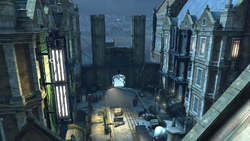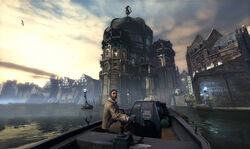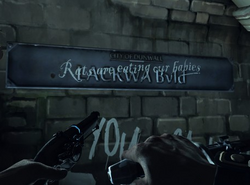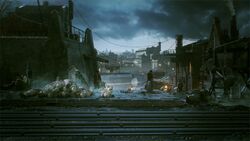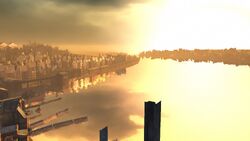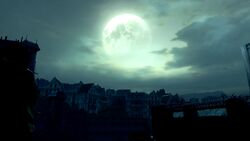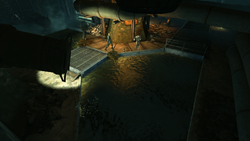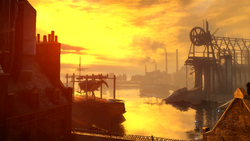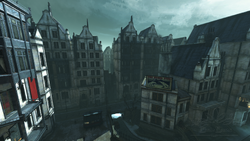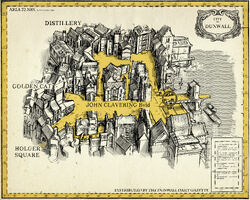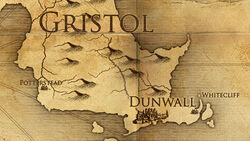No edit summary |
|||
| Line 1: | Line 1: | ||
[[File:Dunwall01.png|thumb|250px|Dunwall.]] |
[[File:Dunwall01.png|thumb|250px|Dunwall.]] |
||
| − | '''Dunwall''', the capital of [[Gristol]] and seat of the [[Empire of the Isles| |
+ | '''Dunwall''', the capital of [[Gristol]] and seat of the [[Empire of the Isles|Imperial government of the Isles]], is an industrial whaling city-state that serves as the central setting for ''[[Dishonored]]''. [[Whaling Trawler|Whaling trawlers]] pack its harbor, bringing in a constant stream of the [[Whale Oil|whale oil]] that powers its industrial revolution. |
==History and Geography== |
==History and Geography== |
||
Revision as of 21:02, 1 April 2014

Dunwall.
Dunwall, the capital of Gristol and seat of the Imperial government of the Isles, is an industrial whaling city-state that serves as the central setting for Dishonored. Whaling trawlers pack its harbor, bringing in a constant stream of the whale oil that powers its industrial revolution.
History and Geography
View of Dunwall and the Wrenhaven from the Distillery District.
The present site that Dunwall occupies was once home to an ancient civilization that collapsed for unknown reasons. Having existed approximately 1000 years before the events of Dishonored, its people worshiped the Outsider and inscribed whale bones with his mark. The ruins were discovered only recently, deep under present-day Dunwall. Many trinkets and artifacts still wash up along Dunwall's shores in the present day.[1]
Originally a small whaling town,[2] Dunwall experienced an industrial boom with the discovery of whale oil's potential as a fuel source by natural philosopher Esmond Roseburrow. This discovery led to the emergence of various technological marvels, from mechanized whaling trawlers to electric lighting and security devices, many created by the inventor Anton Sokolov.
Dunwall itself is divided by the Wrenhaven, a vast river that separates the city in twain and leads out into the sea. Kingsparrow Island, located where the river meets the sea, is the only island known to exist off Dunwall. Dunwall is also dominated by rocky outcroppings and numerous cliffs, which are in turn topped by multiple factories and manors.
Dunwall is an expansive city comprised of numerous districts and locations, from the wealthy Estate District to the declining Drapers Ward and the ruined Flooded District.
The Rat Plague
A warning sign about the plague in Dunwall.
The rat plague, a virulent and deadly disease originally from the distant Pandyssian Continent, emerged in Dunwall's poorest districts and decimated the city's population. Following a plea for aid from Empress Jessamine Kaldwin, the other nations of the Empire blockaded Dunwall to prevent the disease from spreading outside the city. Although the Empress rejected early efforts to establish quarantines and martial law to combat the plague, her assassination allowed Lord Regent Hiram Burrows to enforce aggressive policies, including using military technology to enforce social control. Desperation within the city led to riots and chaos as Dunwall's government became increasingly oppressive and obtrusive.
Walls of Light control the flow of movement within the city, and the City Watch patrols the streets with a strict curfew imposed from dusk to dawn. An ever-increasing wealth gap secures health for those fortunate to have enough money, as the upper classes and their retinues hoard the elixirs that stave off the plague. Gang activity has become rampant, strengthened by lax law enforcement and the collapse of industry within the city. Amid the chaos, corruption thrives.
Society
Plague survivors.
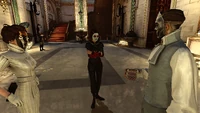
Aristocrats in masks at the Boyle Mansion.
Dunwall is known for extreme class division and xenophobia. The poor form the lowest stratum of society, and are the target of biological warfare aimed at eradicating poverty by decimating the underclass.[3] During plague time, Survivors represent those who have survived the plague but are downtrodden and oppressed. They are encouraged to join the Navy[4] or, in the case of children, the Abbey[5] in return for protection from the plague.
The aristocracy continues to thrive even during the prevalence of the plague, many of them belonging to influential families such as the Carmines, Inchmouths, Boyles and Pendletons. Individuals from other nations within the Empire are not highly regarded, and are not often seen among the privileged classes; Corvo Attano and Anton Sokolov are the only known exceptions, both of whom experience degradation due to their nationality.[6][7] Further, it is common belief that marriage between members of Gristol's aristocracy and people of other nations "dirties the blood."[citation needed]
Adherence to the Abbey of the Everyman is widespread, yet cultists of the Outsider prevail in the city's many dark corners. Cuisine is also divided--for the downtrodden, there are cheap canned goods and rations, and for Dunwall's upper classes, expensive foods, whiskeys and ciders are imported from across the Isles.
Law and Order
The Dunwall City Watch is the primary law enforcement agency for the entire city, with three different tiers: the Lower Watch, the Guards, the Officers and a specialized rank, the Tallboys. During the reign of Hiram Burrows, the Abbey of the Everyman's Overseers work alongside the Watch, given all the powers of a civil police,[8] though they largely deal with crimes of heresy. Regardless, criminal organizations such as the Dead Eels, the Hatters, and the Bottle Street gang, continue to thrive.
Architecture
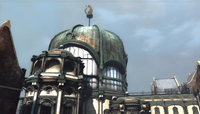
The dome of the Golden Cat.
Kaldwin's Bridge.
Much of Dunwall's architecture is derived from a mixture of real-world architectural influences: Dunwall Tower exhibits gothic architecture, the Golden Cat resembles art nouveau, and the Boyle Mansion is heavily Victorian. The majority of housing is Victorian in style and is comprised of only a few different designs that can be found almost everywhere in the city. Industrial influences are also present, such as in the expansion of Dunwall Tower, Kaldwin's Bridge, and quarantine barriers.
Predictably, areas of affluence such as the Estate District exhibit the city's most elaborate architectural influences, which poorer districts are comprised of simpler, more utilitarian structures. The latter also experience the heaviest deterioration during the plague, due to lack of civil maintenance; the Rudshore Financial District and Drapers Ward act as major exceptions following the breaking of the river barriers and the rise of gang warfare, respectively.
Technology and Transportation
Dunwall, being one of the most industrialized cities of the Isles, possesses numerous advanced technologies from the mundane to the sophisticated. Electric lighting and heaters are common in almost every home, while for security purposes, walls of light and arc pylons are utilized to control movement. The most infamous of these technologies is the Tallboy, a heavily armored soldier armed with explosive arrows, walking on motorized stilts. Almost all of these technologies are powered by whale oil.
Due to Dunwall's port environment, boats from small motor boats to massive, hulking whaling trawlers form the bulk of transportation in and out of Dunwall. On the ground, railway tracks provide transport for the City Watch and smaller rail cars are used by the aristocracy as a means of personal transport. Elevated rail lines provide fast and easy transport for people, cargo and even corpses.
Important Locations
Wrenhaven River
The Wrenhaven River runs through the middle of Dunwall. The river is used by whaling trawlers to haul their catch to the many slaughterhouses along its shores and also provides easy access to most locations across Dunwall, such as Dunwall Tower and Estate District. The Wrenhaven River continues farther north past the city limits and into the southeast part of Gristol.
Dunwall Tower
A heavily-protected palace that has been home to the royal family of the Isles for many years, Dunwall Tower is connected to the city from either its main gate or the waterlock, granting access to small boats. It saw many fortifications added under the regency of Hiram Burrows, such as a safe planning room on the roof and reinforced ramparts, but also a radio station to broadcast propaganda announcements all over the city. It is connected to Coldridge Prison by a drawbridge overlooking a second waterlock.
Coldridge Prison
The most infamous penitentiary across the Empire, Coldridge Prison is where Dunwall's criminals are kept. It uses a variety of innovations created by the Royal Physician Anton Sokolov to prevent escapes and features an interrogation room and an execution yard.
Dunwall Sewers
Deep beneath the city lies the Dunwall Sewers, a complex network of underground passageways, chambers and pipes, some completely flooded. Other than being a home for the poor, they are notorious for containing river krusts and weepers. They are also used as a means of secretly traversing the city and, in later years, a dumping ground for bodies.
Distillery District
The Distillery District, by way of John Clavering Boulevard, was originally connected by a bridge to another district, however that bridge has since been destroyed. Much of the district is run down and polluted. The area alongside the boulevard is lined with mansions, yet the backstreets are controlled by the Bottle Street Gang. The Dunwall Whiskey Distillery is located here.
Holger Square
Home of the Office of the High Overseer, Holger Square is the headquarters of the Abbey of the Everyman. It is here that the Abbey manages itself, particularly in official meetings, the development of new tactics to combat heretics, and the training of hounds. It is also where the ashes of previous High Overseers and High Oracles are interred.
The Golden Cat
A prominent brothel with a decadent appearance in stark contrast to the rest of Dunwall, the Golden Cat recently reopened after a plague outbreak. Many of the courtesans there are brought against their will--most of them being bastard daughters and unwanted children[9]. The brothel is run by Madame Prudence, and caters to wealthy clients.
Kaldwin's Bridge
Spanning the Wrenhaven River, Kaldwin's Bridge was commissioned by Emperor Euhorn Kaldwin. Houses, apartments and warehouses are built along the sides of the bridge, and at its center is a massive elevator drawbridge that allows ships to pass through. The curfew instated by the Lord Regent now prevents evening strolling along the bridge, and renovation and fortification works were initiated as additional defenses. Anton Sokolov's safehouse is located on the north end of the bridge.
Estate District
The Estate District, a wealthy, upper class district built on the banks of an estuary, contains many canals allowing small boat access. Among the restaurants and fine houses, the Boyle Mansion, home of the Boyle family, can be found here, but since the plague outbreak, many buildings lie abandoned and infested with rats and weepers. The district is heavily guarded, particularly during social events such as the Boyle costume ball.
Flooded District
Once known as the Rudshore Financial District, the Flooded District was originally a thriving commercial and industrial district, home to the Dunwall Chamber of Commerce and the Greaves Whaling House. However, when the river barrier broke due to years of neglect, it soon became a haven for weepers, river krusts and a mysterious group of assassins. The regency has made use of the district by exiling the infected to the area and quarantining it from the rest of the city.
Old Port District
A quarantined area adjacent to the Flooded District, the Old Port District has been emptied due to plague infection. The headquarters of the Loyalist Conspiracy, the Hound Pits Pub, is located here.
Kingsparrow Island
Kingsparrow Island is the only island off the Dunwall coast. Following the Morley Insurrection, the island was fortified as a military bastion. During the reign of the Lord Regent, it was modified even further, with the addition of many new Sokolov technologies and a lighthouse doted of its own broadcast station.[10]
Slaughterhouse Row
An industrial whaling district, Slaughterhouse Row is a docking location for whaling trawlers with catch destined for the slaughterhouses that line on the river. Notable establishments here include the Rothwild Slaughterhouse.
Legal District
Another major district of Dunwall, the Legal District contains many major offices of government, including the Timsh Estate and Law Offices, office of the City Barrister, Arnold Timsh. Most buildings there have been emptied under plague provisions, while the district is kept under lock-down by the City Watch to prevent looting.
Drapers Ward
Once a major textile production across the Isles with its water-powered textile mills and boat docks, Drapers Ward was reformed into a high-class clothing center for the gentry of Dunwall before declining again due to the rising criminality and the plague. The territory is now disputed between the Hatters and Dead Eels gangs, where they both set base.
Mutcherhaven District
Located along the Wrenhaven River outside the quarantine blockades of Dunwall, the Mutcherhaven District is home to some of the oldest estates in the city, including the Brigmore Manor. The structure was abandoned following the decline of the Brigmore family during the whale oil industrial revolution, and is now occupied by the Brigmore Witches.
Civil Services District
This district is mentioned in announcements over the loudspeakers once Corvo returns from Holger Square after the mission, High Overseer Campbell. It is here that emergency grain will be supplied to those with the proper food coupons and ration requests.
Tailors' District
According to an Overseer's covert field report, this district housed an Outsider Shrine visited by Daud at one time. It was also here that a riot occurs the night before the mission, Return to the Tower. People demand food, elixir against the plague, and better treatment, but they are repelled by stilt walker guards who set some of them on fire.
Trivia
- Dunwall is strongly inspired by London and Edinburgh, as well as British and American whaling towns as they existed in the 19th century.
- 'Dun' is Old English for gray or drab, and is also a Scottish/Irish Gaelic term for 'fort'. Both of these definitions hint at aspects of the city.
Gallery
References
- ↑ Outsider Shrines Speeches: The Royal Physician
- ↑ Official Dishonored website: Discover Dunwall - Energy
- ↑ The Lord Regent’s Confession
- ↑ "Citizens displaced by quarantine measures are reminded that the Dunwall Navy has bunks, food and salary, and in some cases, legal amnesty available for qualified applicants. Report to a recruiter to learn more about the opportunities in service to the Lord Regent."
- ↑ "Attention Dunwall Citizens: You are urged to consider presenting children between the ages of seven and ten to the Abbey to be tested. As Overseers, they will be provided for, and serve the wellbeing [sic] of the community and the city."
- ↑ The Royal Protector
- ↑ "Yes, Sokolov's a foreigner - with the looks and manner of a Tyvian Swineherd. But he is also a great genius."
- ↑ Loudspeaker Announcement: "...in this continuing crisis, the Overseers of the Abbey of the Everyman remain in service of the state, and are empowered to enforce whenever and wherever necessary..."
- ↑ "They ship them in from farming villages, bastard daughters and extra mouths that can't be fed."
- ↑ The Lighthouse
Cities in the Empire of the Isles | |
|---|---|
| Tyvia |
Alexin • Caltan • Dabokva • Meya • Pradym • Samara • Tamarak • Yaro • Wei-Ghon |
| Morley | |
| Gristol |
Baleton • Driscol • Dunwall • Old Lamprow • Poolwick • Potterstead • Redmoor • Whitecliff |
| Serkonos |
Bastillian • Cullero • Karnaca • Saggunto |



